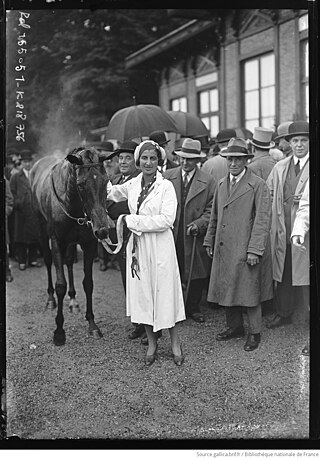
Nearco was an Italian-bred Thoroughbred racehorse described by Thoroughbred Heritage as "one of the greatest racehorses of the Twentieth Century" and "one of the most important sires of the century." He was unbeaten, winning 14 races at distances from 1000m to 3000m, including the Derby Italiano and Grand Prix de Paris. He was then sold for a record amount to Martin H. Benson and stood stud in England, where he became the patriarch of several of the most dominant sire lines in Thoroughbred history.

Djebel (1937–1958) was a French Thoroughbred racehorse, who won 15 of 22 races during 1939–1942 including the Prix d'Essai, 2000 Guineas and Prix de l'Arc de Triomphe. He was later a leading sire in France and is responsible for the survival of the Byerley Turk sire line into the 21st century.

Ksar (1918–1937) was a French Thoroughbred racehorse who had back-to-back wins in France's most prestigious horse race, the Prix de l'Arc de Triomphe.

Ajax was an undefeated French Thoroughbred racehorse who won the 1904 Prix du Jockey Club and Grand Prix de Paris and was an influential sire.
Michel Bras is a French chef. His restaurant located in Laguiole in the Aveyron was rated three stars in the Guide Michelin since 1999. It is also classed in the "Relais & Châteaux" since 1992. He was classed several times among the 10 best restaurants in the world.

Pearl Cap was a French champion Thoroughbred racehorse who is considered one of her country's greatest racing fillies.
Le Pacha was a Champion French Thoroughbred racehorse. Bred by Andre Schwob, his dam was Advertencia, a daughter of two-time Arc winner, Ksar. He was sired by Biribi who won the 1926 Prix de l'Arc de Triomphe and who was a son of the three-time Leading sire in France, Rabelais.
Nimbus (1946–1972) was a British Thoroughbred racehorse. In a racing career which lasted from the spring of 1948 until August 1949, he ran nine times and won six races. Nimbus ran successfully as a two-year-old in 1948, winning the July Stakes, but reached his peak the following year. He won close finishes in both the 2000 Guineas and The Derby but was unable to attempt the Triple Crown after his career was ended by injury. He had modest success as a breeding stallion.
Nonoalco (1971–1992) was an American-bred Thoroughbred racehorse who raced in France.

The Goulet de Brest is a 3-km-long strait linking the roadstead of Brest to the Atlantic Ocean. Only 1.8 km wide, the goulet is situated between the Pointe du Petit Minou and the Pointe du Portzic to the north and the îlot des Capucins and the Pointe des Espagnols to the south.
Raintrap is a British Thoroughbred racehorse and sire.

Pharos was a British bred thoroughbred racehorse and a leading sire in Great Britain and Ireland.
Greek Money was an American Thoroughbred racehorse best known for winning the second leg of the U.S. Triple Crown series, the Preakness Stakes.
Vieux Manoir (1947–1981) was a French Thoroughbred racehorse and Champion sire.

The Rue des Capucins is a street located in the 1st arrondissement of Lyon, between the slopes of La Croix-Rousse and the Place des Terreaux. Straight but slightly inclined, it continues the rue du Sergent Blandan, begins with the Place des Capucins and ends on the Place Croix-Paquet. It is parallel to the rue René Laynaud. The street belongs to the zone classified World Heritage Site by UNESCO.

Théâtre des Capucins is a theatre in Luxembourg City, Luxembourg. It is part of the Théâtres de la Ville de Luxembourg. Directed by Frank Feitler, the Capucin Theater is located in the heart of the Old Town. It puts on performances in German, French and Luxembourgish.
Grey Sovereign (1948–1976) was a British Thoroughbred racehorse and sire. As a racehorse he was a successful sprinter but not a champion, recording his biggest success when he won the Richmond Stakes as a two-year-old in 1950. His career was compromised by his difficult and unpredictable temperament. After his retirement from racing he became a successful and influential breeding stallion.

Sardanapale (1911–1934) was a French Thoroughbred racehorse and sire. He showed considerable talent as a juvenile, winning the Prix Yacowlef, Prix Morny and Prix de Seine-et-Oise. In the following year, he recovered from two defeats by La Farina to establish himself as the best racehorse in Europe with a string of victories which included the Prix Hocquart, Prix d'Hédouville, Prix du Jockey Club, Grand Prix de Paris, Prix de President de la Republique and Prix Eugène Adam before his racing career was ended by the outbreak of the First World War. He has been rated one of the best horses ever to be trained in France.
Rodosto was a French Thoroughbred racehorse and sire. He showed very good form as a juvenile in 1932 when he won the Prix Herod and was placed in both the Prix Robert Papin and the Prix Morny. In the following spring he won the Prix de La Jonchere and then became the first horse to win both the 2000 Guineas and Poule d'Essai des Poulains. He missed the Epsom Derby through injury and failed to recover his form that year. As a four-year-old he won a second Prix de La Jonchere before going on to win the Prix des Sablons, Prix d'Ispahan and Prix du Chemin de Fer du Nord. After his retirement from racing Rodosto had some success at a breeding stallion in France and Argentina.
Dollar (1860–1887) was a Thoroughbred racehorse and sire. He best known as the principal conduit to extend the Byerley Turk sire line to the present day.










